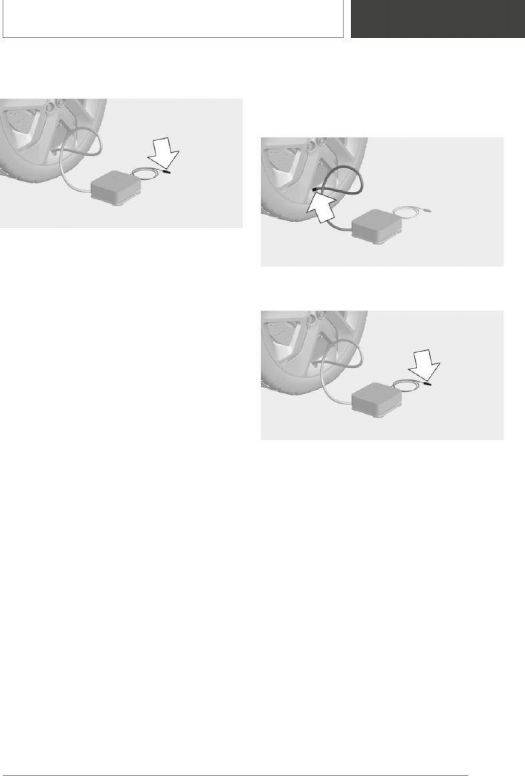
4. Insert the connector into the power socket in‐
side the vehicle.
5. With the ignition switched on or the engine
running, switch on the compressor.
If a tire inflation pressure of at least 2 bar can‐
not be reached, contact your dealer's service
center or another qualified service center or
repair shop.
If a tire inflation pressure of at least 2 bar is
reached, see Minimum tire inflation pressure
is reached.
6. Unscrew the connection hose of the com‐
pressor from the tire valve.
7. Pull the connector out of the power socket
inside the vehicle.
8. Stow the Mobility System in the vehicle.
Minimum tire inflation pressure is
reached
1.
Unscrew the connection hose of the com‐
pressor from the tire valve.
2. Pull the connector out of the power socket
inside the vehicle.
3. Stow the Mobility System in the vehicle.
4. Immediately drive approx. 5 miles/10 km to
ensure that the sealant is evenly distributed in
the tire.
Do not exceed a speed of 50 mph/80 km/h.
If possible, do not drive at speeds less than
12 mph/20 km/h.
Adjustment
1. Stop at a suitable location.
2. Screw the connection hose of the compres‐
sor directly onto the tire valve stem.
3. Insert the connector into the power socket in‐
side the vehicle.
4. Correct the tire inflation pressure to at least
2.0 bar.
▷ Increase tire inflation pressure: with the ig‐
nition switched on or the engine running,
switch on the compressor.
▷ To reduce the pressure: press the button
on the compressor.
5. Unscrew the connection hose of the com‐
pressor from the tire valve.
6. Pull the connector out of the power socket
inside the vehicle.
7. Stow the Mobility System in the vehicle.
Continuing the trip
Do not exceed the maximum permissible speed
of 50 mph/80 km/h.
Reinitialize the Flat Tire Monitor.
Reset the Tire Pressure Monitor TPM.
Seite 243
Wheels and tires
MOBILITY
243
Online Edition for Part no. 01405A10C39 - VI/20











































































































































































































































































































